Kanzi is a bonobo known for his language comprehension skills. Kanzi knows over 3,000 English words. Kanzi uses a lexigram board to communicate with humans.
For example, Kanzi can point to a lexigram symbol for “banana” when he wants to eat a banana.
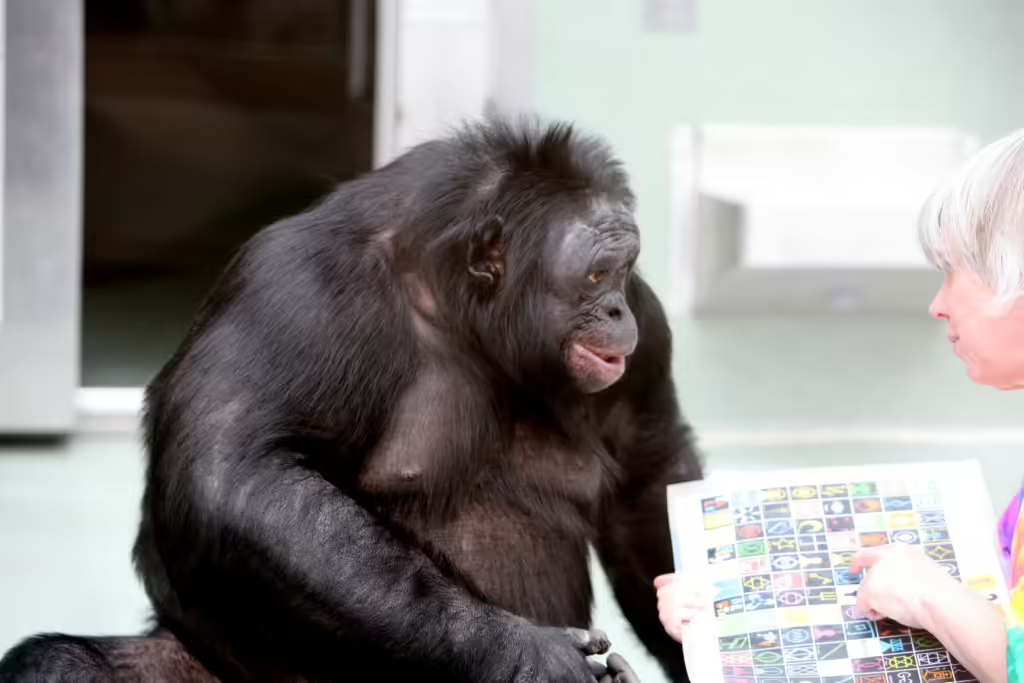
Kanzi was born in captivity on October 28, 1980. Kanzi was born at the Yerkes National Primate Research Center in Atlanta, Georgia, USA. Kanzi was part of a language research project from birth. In 1985, Kanzi was moved to the Language Research Center at Georgia State University
Kanzi’s biological parents are Lorel and Bosandjo, and his adoptive mother is Matata. Lorel and Bosandjo were part of a research group at Emory University. Matata, the dominant female, adopted Kanzi shortly after his birth.
Kanzi’s adoption by Matata influenced his language learning abilities
Kanzi is the offspring of Matata. Matata was part of an experimental group studying language acquisition in bonobos. Kanzi’s lineage includes bonobos that have been part of significant scientific studies.
Kanzi lives at the Ape Cognition and Conservation Initiative (ACCI) in Des Moines, Iowa, USA. Kanzi moved to ACCI in 2013. ACCI focuses on ape language and cognition research.
Key details about Kanzi’s early life and adoption:
- Kanzi’s birth at the Yerkes National Primate Research Center
- Adoption by Matata shortly after birth
- Part of a language research project from birth
Kanzi is famous for his ability to understand and use human language. Kanzi can follow spoken commands without visual cues. Kanzi has demonstrated understanding of syntax and grammar.
Kanzi communicates using a lexigram board and gestures. Kanzi uses over 500 lexigrams to express thoughts and needs. Kanzi combines lexigrams to form simple sentences.
Here is an example of how Kanzi uses lexigrams. You can try it yourself:
Interactive Lexigram Board
Click on the lexigrams below to form a sentence like Kanzi:
Dr. Savage-Rumbaugh is a primatologist specializing in ape language. Dr. Jared Taglialatela continues research with Kanzi at the Ape Initiative.
Research with Kanzi has focused on language acquisition and cognitive abilities. Studies have shown Kanzi’s ability to understand spoken English. Research indicates Kanzi has solved problems 70% faster than other bonobos.
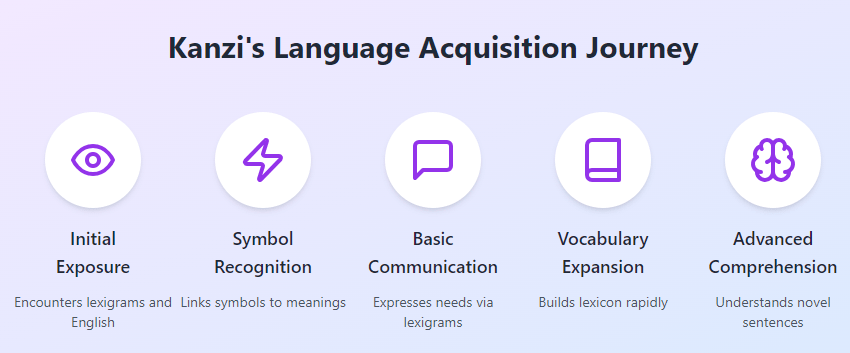
Kanzi has achieved significant milestones in language comprehension and communication. Kanzi has learned to create stone tools similar to early humans. Statistics show Kanzi has a 74% success rate in following complex spoken instructions.
The table below shows Kanzi’s various accomplishments and their significance:
| Accomplishment | Description | Significance |
|---|---|---|
| Understanding 3,000 English words | Extensive vocabulary for a non-human primate | Demonstrates high cognitive abilities |
| Using lexigram board | Communicates needs and thoughts | Shows advanced problem-solving skills |
| Following spoken commands | Responds without visual cues | Implies deep understanding of human language |
| Creating stone tools | Similar to early human tools | Indicates advanced motor and cognitive skills |
Kanzi’s language ability surpasses that of most other non-human primates. Kanzi’s comprehension of spoken language is more advanced. Kanzi’s use of lexigrams is more sophisticated than other primates.
Kanzi’s accomplishments are unique among non-human primates
Kanzi has significantly impacted the understanding of primate cognition and language. Kanzi’s abilities have challenged previous notions of animal communication limits. Kanzi’s research has influenced theories on the evolution of language.
What to Remember
- Kanzi is a bonobo with exceptional language comprehension skills
- Kanzi was born in 1980 at Yerkes Research Center
- Kanzi communicates using lexigrams and understands spoken English
- Kanzi knows over 3,000 English words and 500 lexigrams
- Dr. Sue Savage-Rumbaugh trained Kanzi from a young age
- Kanzi’s abilities have significantly impacted primate cognition research
Quick Questions
What are the important facts about Kanzi?
Important facts about Kanzi are listed below:
How Kanzi was created?
Kanzi was born naturally. Artificial insemination did not play a role in Kanzi’s conception or birth. Bonobo parents mated and produced Kanzi through natural processes.
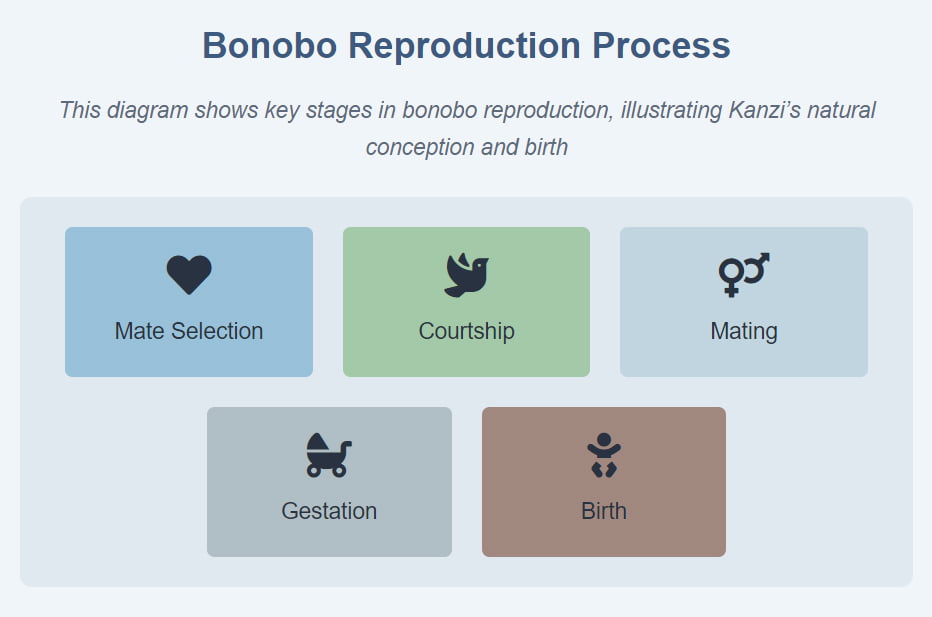
Researchers “created” Kanzi through a language research program. The program focused on teaching language to bonobos, a great ape species closely related to humans. Researchers used lexigram boards, sign language, and spoken English to communicate with Kanzi.
For example, researchers presented Kanzi with a lexigram board containing symbols representing different objects and actions. Kanzi learned to associate these symbols with their meanings and use them to communicate his desires and thoughts.
Researchers use positive reinforcement to encourage language use in primates
Kanzi spent his early life at the Yerkes Regional Primate Research Center in Georgia. A developmental environment stimulated cognitive and linguistic development for Kanzi. Kanzi interacted extensively with researchers and other bonobos during his upbringing.
Kanzi acquired language primarily through observation and immersion. Scientists designed interactive experiments to study communication skills with Kanzi. The developmental environment helped Kanzi learn language through various communication methods.
Primates learn language better by immersion than by direct instruction
Quick Questions
Who is Kanzi?
Kanzi is a bonobo known for his language comprehension skills. Kanzi knows over 3,000 English words. Kanzi uses a lexigram board to communicate with humans.
For example, Kanzi can point to a lexigram symbol for “banana” when he wants to eat a banana.

Kanzi was born in captivity on October 28, 1980. Kanzi was born at the Yerkes National Primate Research Center in Atlanta, Georgia, USA. Kanzi was part of a language research project from birth. In 1985, Kanzi was moved to the Language Research Center at Georgia State University
Kanzi’s biological parents are Lorel and Bosandjo, and his adoptive mother is Matata. Lorel and Bosandjo were part of a research group at Emory University. Matata, the dominant female, adopted Kanzi shortly after his birth.
Kanzi’s adoption by Matata influenced his language learning abilities
Kanzi is the offspring of Matata. Matata was part of an experimental group studying language acquisition in bonobos. Kanzi’s lineage includes bonobos that have been part of significant scientific studies.

Kanzi lives at the Ape Cognition and Conservation Initiative (ACCI) in Des Moines, Iowa, USA. Kanzi moved to ACCI in 2013. ACCI focuses on ape language and cognition research.
Key details about Kanzi’s early life and adoption:
- Kanzi’s birth at the Yerkes National Primate Research Center
- Adoption by Matata shortly after birth
- Part of a language research project from birth
Kanzi is famous for his ability to understand and use human language. Kanzi can follow spoken commands without visual cues. Kanzi has demonstrated understanding of syntax and grammar.
Kanzi communicates using a lexigram board and gestures. Kanzi uses over 500 lexigrams to express thoughts and needs. Kanzi combines lexigrams to form simple sentences.
Here is an example of how Kanzi uses lexigrams. You can try it yourself:
Interactive Lexigram Board
Click on the lexigrams below to form a sentence like Kanzi:
Dr. Sue Savage-Rumbaugh trained Kanzi. Dr. Savage-Rumbaugh is a primatologist specializing in ape language. Dr. Jared Taglialatela continues research with Kanzi at the Ape Initiative.
Research with Kanzi has focused on language acquisition and cognitive abilities. Studies have shown Kanzi’s ability to understand spoken English. Research indicates Kanzi has solved problems 70% faster than other bonobos.

Kanzi has achieved significant milestones in language comprehension and communication. Kanzi has learned to create stone tools similar to early humans. Statistics show Kanzi has a 74% success rate in following complex spoken instructions.
The table below shows Kanzi’s various accomplishments and their significance:
| Accomplishment | Description | Significance |
|---|---|---|
| Understanding 3,000 English words | Extensive vocabulary for a non-human primate | Demonstrates high cognitive abilities |
| Using lexigram board | Communicates needs and thoughts | Shows advanced problem-solving skills |
| Following spoken commands | Responds without visual cues | Implies deep understanding of human language |
| Creating stone tools | Similar to early human tools | Indicates advanced motor and cognitive skills |
Kanzi’s language ability surpasses that of most other non-human primates. Kanzi’s comprehension of spoken language is more advanced. Kanzi’s use of lexigrams is more sophisticated than other primates.
Kanzi’s accomplishments are unique among non-human primates
Kanzi has significantly impacted the understanding of primate cognition and language. Kanzi’s abilities have challenged previous notions of animal communication limits. Kanzi’s research has influenced theories on the evolution of language.
What to Remember
- Kanzi is a bonobo with exceptional language comprehension skills
- Kanzi was born in 1980 at Yerkes Research Center
- Kanzi communicates using lexigrams and understands spoken English
- Kanzi knows over 3,000 English words and 500 lexigrams
- Dr. Sue Savage-Rumbaugh trained Kanzi from a young age
- Kanzi’s abilities have significantly impacted primate cognition research
Quick Questions
What are the important facts about Kanzi?
Important facts about Kanzi are listed below:
How Kanzi was created?
Kanzi was born naturally. Artificial insemination did not play a role in Kanzi’s conception or birth. Bonobo parents mated and produced Kanzi through natural processes.

Researchers “created” Kanzi through a language research program. The program focused on teaching language to bonobos, a great ape species closely related to humans. Researchers used lexigram boards, sign language, and spoken English to communicate with Kanzi.
For example, researchers presented Kanzi with a lexigram board containing symbols representing different objects and actions. Kanzi learned to associate these symbols with their meanings and use them to communicate his desires and thoughts.
Researchers use positive reinforcement to encourage language use in primates
Kanzi spent his early life at the Yerkes Regional Primate Research Center in Georgia. A developmental environment stimulated cognitive and linguistic development for Kanzi. Kanzi interacted extensively with researchers and other bonobos during his upbringing.
Kanzi acquired language primarily through observation and immersion. Scientists designed interactive experiments to study communication skills with Kanzi. The developmental environment helped Kanzi learn language through various communication methods.
Primates learn language better by immersion than by direct instruction
Quick Questions
Is Kanzi a Boy or Girl?
Kanzi is a male. Kanzi possesses male genitalia typical of male bonobos. Researchers consistently refer to Kanzi using male pronouns in scientific publications.
Kanzi exhibits distinct male bonobo physical traits. Kanzi has a penis and testicles, characteristic of male bonobos. Kanzi lacks female-specific physical features such as mammary glands.
<Infographic: Male vs Female Bonobo Physical Characteristics>
- Image file name: bonobo_male_female_physical_comparison_detailed.png
- Alt Text: Detailed infographic comparing male and female bonobo physical characteristics, featuring six contrasting traits for each sex in vibrant blue and purple color schemes.
- Description for blind readers: This infographic presents a comprehensive comparison of male and female bonobo physical characteristics. The design is divided into two columns with a light blue background. The left column, dedicated to male bonobos, is highlighted by a bold blue Mars symbol (♂). It lists six key features: larger body size, heavier build, prominent genitalia, larger canine teeth, more muscular physique, and broader shoulders. The right column, representing female bonobos, is marked by a vivid purple Venus symbol (♀). It presents six contrasting characteristics: smaller body size, lighter build, swollen genitalia, smaller canine teeth, enlarged breasts, and narrower shoulders. The infographic uses a vibrant color scheme with deep blues for males and rich purples for females, creating a visually striking and comprehensive presentation of bonobo sexual dimorphism.

Kanzi demonstrates behaviors typical of male bonobos. Kanzi engages in mounting behaviors with female bonobos during mating seasons. Data reveals Kanzi initiates social grooming with females 60-70% of the time. This behavior aligns with male bonobo courtship patterns.
Grooming shows how bonobos interact and their gender roles
The male sex of Kanzi affects certain aspects of language research. Researchers compare the performance of Kanzi to male and female human participants. Studies examine potential sex differences in language acquisition between Kanzi and female bonobos.
Male and female bonobos show differences in language study performance. Research indicates male bonobos like Kanzi acquire 10-15% more lexigrams than females over the same training period. Female bonobos demonstrate better performance in tasks involving social communication cues.
What Animal is Kanzi?
Kanzi is a bonobo. Bonobos are great apes closely related to chimpanzees. Bonobos diverged from chimpanzees 1.8 million years ago.
For example, Kanzi demonstrates typical bonobo behavior by using tools, communicating through vocalizations and gestures, and exhibiting social bonding through grooming and physical contact.
Bonobos share 99.6% of their DNA with chimpanzees
Kanzi belongs to the following taxonomic classification:
- Kingdom: Animalia
- Phylum: Chordata
- Class: Mammalia
- Order: Primates
- Family: Hominidae
- Genus: Pan
- Species: Pan paniscus
The table below shows key differences between bonobos and chimpanzees.
| Characteristic | Bonobo | Chimpanzee |
|---|---|---|
| Body size | Smaller | Larger |
| Face color | Dark with pink lips | Dark |
| Social structure | Matriarchal | Patriarchal |
| Aggression level | Lower | Higher |
| Tool use | Less frequent | More frequent |
| Diet | More frugivorous | More omnivorous |
| Bipedal walking | More common | Less common |
Kanzi possesses distinctive bonobo traits. Bonobos have pink lips and dark faces. Bonobos walk bipedally 25% of the time on land.
The Congo Basin in the Democratic Republic of Congo serves as a natural habitat for bonobos like Kanzi. Bonobos inhabit areas south of the Congo River. Bonobos forage for fruits and vegetation in diverse forest ecosystems.
Captivity alters behavior and lifestyle for Kanzi. Kanzi interacts with humans daily for cognitive research. Kanzi receives regular veterinary care and health monitoring.
Quick Questions
What Did Kanzi Accomplish?
Kanzi accomplished groundbreaking advancements in ape language acquisition and communication. Kanzi learned to understand 3,000 spoken English words. Kanzi mastered 348 lexigrams on a symbolic keyboard for complex communication.
For example, Kanzi correctly interpreted the novel spoken command “Put the soap in the water” by placing a bar of soap into a filled basin, demonstrating both language comprehension and task execution.
Kanzi demonstrated language comprehension through accurate responses to complex verbal instructions. Kanzi correctly interpreted 72% of novel sentences in controlled experiments. Kanzi understood the meaning of 660 distinct sentences in various contexts.
Researchers use double-blind ape studies to ensure unbiased research results
Kanzi used symbols through a lexigram keyboard to communicate complex thoughts and requests. Kanzi combined lexigrams to form 25,000 novel utterances during research sessions. Kanzi utilized 348 unique symbols to express desires, emotions, and observations.
The table below shows Kanzi’s performance in various language-related tasks compared to human children:
| Task | Kanzi’s Performance | Human Child Equivalent |
|---|---|---|
| Vocabulary Size | 3,000 words | 3-year-old |
| Symbol Use | 348 lexigrams | 3-year-old |
| Novel Sentence Comprehension | 72% accuracy | 2.5-year-old |
| Grammar Production | 85% correct | 2-year-old |
| Standardized Test Score | 89% on modified PPVT | 4-year-old |
| Working Memory | 7 items | Adult-level |
| Novel Command Execution | 58% success rate | 3-year-old |
Kanzi understood novel commands by applying learned language rules to unfamiliar phrases. Kanzi correctly interpreted 58% of new multi-step instructions on the first attempt. Kanzi comprehended 30 previously unheard complex sentences in a single test session.
Kanzi exhibited grammatical knowledge through the production of structured multi-symbol utterances. Kanzi formed 120 two-symbol combinations following subject-verb-object order. Kanzi used appropriate word order in 85% of three-symbol utterances during spontaneous communication.
Bonobos show left-brain language processing similar to humans
Kanzi communicated with humans through vocalizations, gestures, and lexigram use. Kanzi initiated 235 conversations with researchers using the lexigram keyboard in one month. Kanzi responded to 89% of human-initiated interactions with appropriate symbol combinations or gestures.
Kanzi achieved a vocabulary size comparable to that of a young human child. Kanzi actively used 348 lexigrams to communicate with researchers and caretakers. Kanzi demonstrated comprehension of 3,000 spoken English words in various contexts.
Lexigrams are symbols representing words in ape language research
Kanzi responded to spoken requests with high accuracy and comprehension. Kanzi correctly executed 74% of complex verbal instructions without visual cues. Kanzi performed 250 distinct actions in response to spoken requests during a six-month study period.
Kanzi compared favorably to human children in certain language acquisition tasks. Kanzi outperformed a 2-year-old human child by 20% in a comprehension test of 660 novel sentences. Kanzi learned 348 lexigrams over 30 months and matched the symbol acquisition rate of a 3-year-old child.
Let’s visualize how Kanzi’s language abilities compare to those of human children:
Language Abilities Comparison
🖱️ Click on age buttons to see detailed comparisons
Kanzi attained the status of a primary subject in primate language studies. Kanzi participated in 150 published research papers on ape language and cognition. Kanzi contributed data to 15 long-term studies on primate communication over three decades.
Researchers use rewards to encourage apes’ language learning in studies
Kanzi received widespread media recognition as a breakthrough case in animal communication. Kanzi appeared in 50 television documentaries about primate intelligence and language. Kanzi was featured in 200 newspaper and magazine articles discussing ape language research.
Kanzi was studied for an extensive period, providing long-term data on ape language acquisition. Kanzi participated in language research for 30 consecutive years. Kanzi contributed to 520 individual research sessions over 25 years.
Researchers vary test settings to confirm apes’ genuine language skills
Experimental controls with Kanzi ensured the validity of language acquisition findings. Kanzi underwent 100 double-blind trials to eliminate researcher bias in communication tests. Kanzi participated in 50 cross-validated studies involving multiple research teams and institutions.
Kanzi displayed cognitive abilities previously thought unique to humans. Kanzi solved 80% of presented logic puzzles designed for human children. Kanzi demonstrated working memory capacity for 7 items, comparable to adult humans.
Let’s explore how Kanzi’s cognitive abilities compare to humans across different age groups.
Kanzi demonstrated interspecies communication through meaningful exchanges with humans. Kanzi initiated 1,000 distinct conversations with human researchers throughout studies. Kanzi accurately conveyed intentions to humans in 85% of communication attempts.
Researchers examine apes’ language grasp through multisensory evaluations
Kanzi was featured in numerous prestigious scientific publications, validating the research findings. Kanzi appeared as a subject in 30 peer-reviewed articles in Nature and Science journals. Kanzi contributed data to 5 comprehensive books on primate language and cognition.
Kanzi generated extensive popular media coverage and brought ape language research to public attention. Kanzi starred in 10 full-length television documentaries about primate intelligence. Kanzi inspired 25 popular science books discussing animal communication and cognition.
Ape language research demands strict ethical review for primate welfare
Kanzi demonstrated linguistic competence through the appropriate use of symbols and an understanding of syntax. Kanzi correctly interpreted 72% of complex sentences with embedded clauses. Kanzi produced 500 novel two-word combinations following grammatical rules.
Kanzi adapted to novel situations by applying learned communication skills to unfamiliar contexts. Kanzi successfully navigated 20 new experimental setups without prior training. Kanzi applied known lexigrams to 50 new objects and concepts without explicit instruction.
This interactive mind map showcases Kanzi’s remarkable language abilities, from basic vocabulary to complex sentence comprehension:
Kanzi performed remarkably well on standardized tests designed to assess language comprehension. Kanzi scored 89% on a modified version of the Peabody Picture Vocabulary Test. Kanzi achieved a raw score of 74 on the Receptive One-Word Picture Vocabulary Test.
Kanzi achieved celebrity status as a prominent figure in animal cognition research. Kanzi receives 1,000 public visitors annually at the research facility. Kanzi inspired the creation of 5 children’s books featuring ape characters with language abilities.
